新概念英语第二册 Lesson30
- 格式:ppt
- 大小:997.50 KB
- 文档页数:67

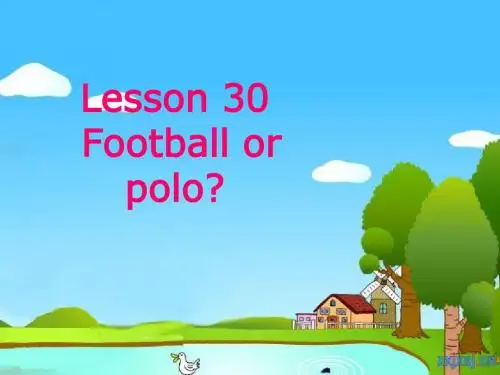
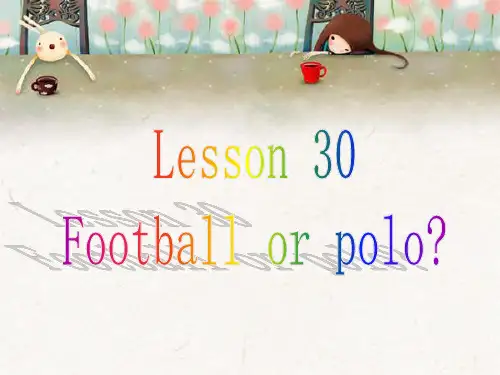
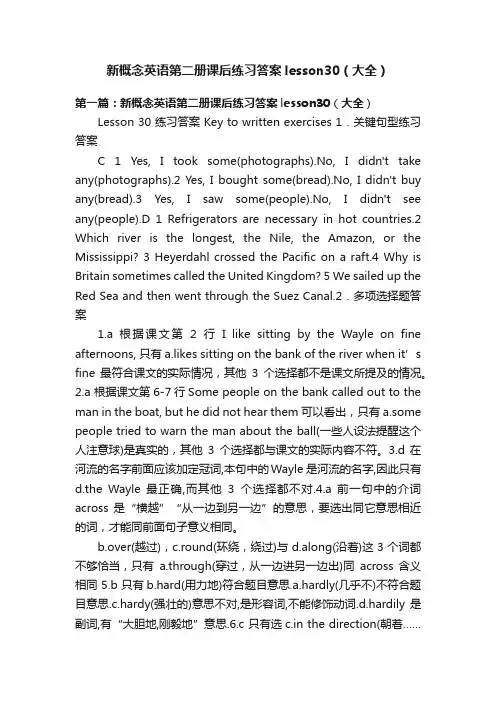
新概念英语第二册课后练习答案lesson30(大全)第一篇:新概念英语第二册课后练习答案lesson30(大全)Lesson 30 练习答案 Key to written exercises 1.关键句型练习答案C 1 Yes, I took some(photographs).No, I didn't take any(photographs).2 Yes, I bought some(bread).No, I didn't buy any(bread).3 Yes, I saw some(people).No, I didn't see any(people).D 1 Refrigerators are necessary in hot countries.2 Which river is the longest, the Nile, the Amazon, or the Mississippi? 3 Heyerdahl crossed the Pacific on a raft.4 Why is Britain sometimes called the United Kingdom? 5 We sailed up the Red Sea and then went through the Suez Canal.2.多项选择题答案1.a 根据课文第2行I like sitting by the Wayle on fine afternoons, 只有a.likes sitting on the bank of the river when it’s fine 最符合课文的实际情况,其他3个选择都不是课文所提及的情况。
2.a 根据课文第6-7行Some people on the bank called out to the man in the boat, but he did not hear them 可以看出,只有a.some people tried to warn the man about the ball(一些人设法提醒这个人注意球)是真实的,其他3个选择都与课文的实际内容不符。
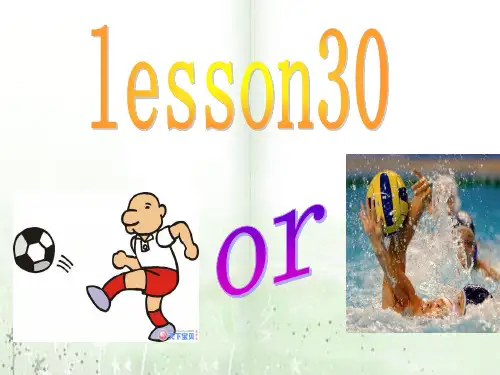
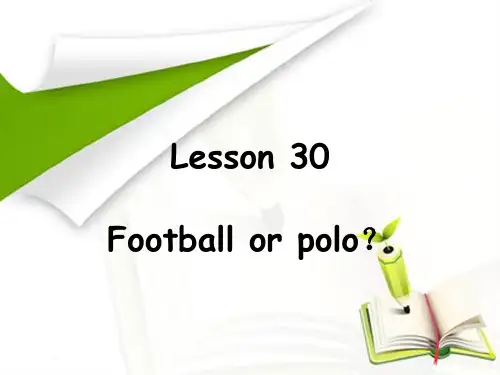
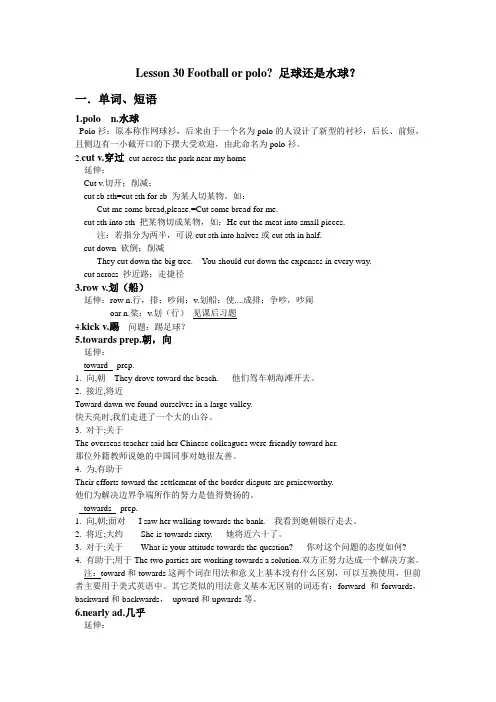
Lesson 30 Football or polo? 足球还是水球?一.单词、短语1.polo n.水球Polo衫:原本称作网球衫,后来由于一个名为polo的人设计了新型的衬衫,后长、前短,且侧边有一小截开口的下摆大受欢迎,由此命名为polo衫。
2.cut v.穿过cut across the park near my home延伸:Cut v.切开;削减;cut sb sth=cut sth for sb 为某人切某物。
如:Cut me some bread,please.=Cut some bread for me.cut sth into sth 把某物切成某物,如:He cut the meat into small pieces.注:若指分为两半,可说cut sth into halves或cut sth in half.cut down 砍倒;削减They cut down the big tree. You should cut down the expenses in every way.cut across 抄近路;走捷径3.row v.划(船)延伸:row n.行,排;吵闹;v.划船:使....成排;争吵,吵闹oar n.桨;v.划(行)见课后习题4.kick v.踢问题:踢足球?5.towards prep.朝,向延伸:toward prep.1. 向,朝They drove toward the beach. 他们驾车朝海滩开去。
2. 接近,将近Toward dawn we found ourselves in a large valley.快天亮时,我们走进了一个大的山谷。
3. 对于;关于The overseas teacher said her Chinese colleagues were friendly toward her.那位外籍教师说她的中国同事对她很友善。
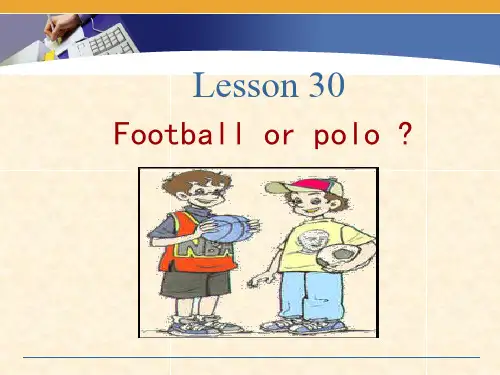
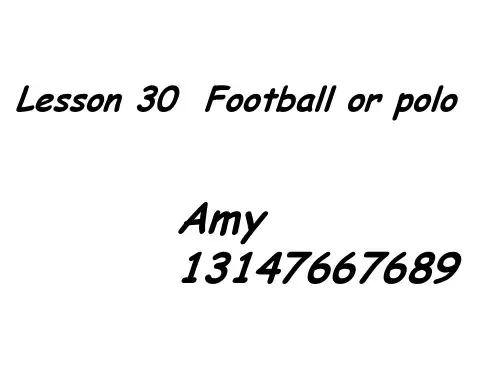
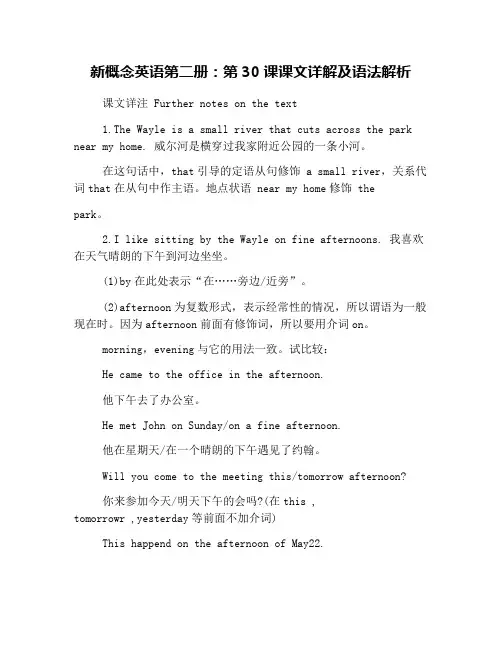
新概念英语第二册:第30课课文详解及语法解析课文详注 Further notes on the text1.The Wayle is a small river that cuts across the park near my home. 威尔河是横穿过我家附近公园的一条小河。
在这句话中,that引导的定语从句修饰 a small river,关系代词that在从句中作主语。
地点状语 near my home修饰 thepark。
2.I like sitting by the Wayle on fine afternoons. 我喜欢在天气晴朗的下午到河边坐坐。
(1)by在此处表示“在……旁边/近旁”。
(2)afternoon为复数形式,表示经常性的情况,所以谓语为一般现在时。
因为afternoon前面有修饰词,所以要用介词on。
morning,evening与它的用法一致。
试比较:He came to the office in the afternoon.他下午去了办公室。
He met John on Sunday/on a fine afternoon.他在星期天/在一个晴朗的下午遇见了约翰。
Will you come to the meeting this/tomorrow afternoon?你来参加今天/明天下午的会吗?(在this ,tomorrowr ,yesterday等前面不加介词)This happend on the afternoon of May22.这事发生于5月22日下午。
(请注意在the afternoon of May22之前要用介词on)3.…it went towards a passing boat.……球便向着一只划过来的小船飞去。
(1)go在此处不是指人“走”,而是指球“行进”。
(2)passing为现在分词,作定语,表示“经过的”、“划过来的”,如a passing plane(一架飞过的飞机)。

Lesson 30 Football or polo? 足球还是水球?1. The Wayle is a small river that cuts across the park near my home. I like sitting by the Wayle on fine afternoons. 威尔河是横穿过我家附近公园的一条小河。
我喜欢在天气晴朗的下午到河边坐坐。
★Wayle n. 威尔(河名)This is a river called wayle.★cut v. 穿过以前最常用的意思是(用锋利的东西)切,割,剪cut oneself cut one's hair(名词,hair-cut)我打算剪头发I am going to cut my hair 或I am going to have a haircut.或have my hair cutcut the tree 砍树/ cut down the tree 砍倒树/ cut the tree down砍倒树cut the head off砍脑袋(off = away from)cut off electricity 切断电源cut sth into pieces把... 切成小片(碎)cut across 直着穿过cut a corner走捷径when you learn english, never cut a corner★by the river★like to do 一次性的喜欢 like doing 习惯性的喜欢★afternoon+s表示“每逢”2.It was warm last Sunday, so I went and sat on the river bank as usual. 上星期日天气很暖和。
于是我和往常一样,又去河边坐着。
3.Some children were playing games on the bank and there were some people rowing on the river. 河岸上有些孩子正在玩耍,河面上有些人正在划船。
Lesson 30 Football or polo? 足球还是水球?1. The Wayle is a small river that cuts across the park near my home. I like sitting by the Wayle on fine afternoons. 威尔河是横穿过我家附近公园的一条小河。
我喜欢在天气晴朗的下午到河边坐坐。
★Wayle n. 威尔(河名)This is a river called wayle.★cut v. 穿过以前最常用的意思是(用锋利的东西)切,割,剪cut oneself cut one's hair(名词,hair-cut)我打算剪头发I am going to cut my hair 或I am going to have a haircut.或have my hair cutcut the tree 砍树/ cut down the tree 砍倒树/ cut the tree down砍倒树cut the head off砍脑袋(off = away from)cut off electricity 切断电源cut sth into pieces把... 切成小片(碎)cut across 直着穿过cut a corner走捷径when you learn english, never cut a corner★by the river★like to do 一次性的喜欢 like doing 习惯性的喜欢★afternoon+s表示“每逢”2.It was warm last Sunday, so I went and sat on the river bank as usual. 上星期日天气很暖和。
于是我和往常一样,又去河边坐着。
3.Some children were playing games on the bank and there were some people rowing on the river. 河岸上有些孩子正在玩耍,河面上有些人正在划船。